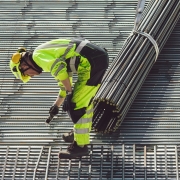The Different Sole Compounds
It is a part of your safety shoe or safety boot that doesn’t get the attention it deserves. Again, a critical component that needs understanding in order to make an informed decision prior to your purchase. All shoes have a sole, which is the bottom of a shoe, the part that comes into full contact with the ground.
Modern Soles can be made from a variety of materials, but most modern safety shoes have soles made from:
- PU (Polyurethane)
- TPU (Thermoplastic Polyurethane)
- Rubber soles
Prior to these compounds – during the 90’s – polyvinyl chloride (PVC) was popular. Today however, it is fairly rare and rather obsolete.
More than 90% of the safety footwear sold and purchased globally will be manufactured out of Polyurethane. Either single density or dual/double density. Dual density has become the global standard due to the fact it offers both a hard-wearing outsole (which takes the impact and pounding of the earth below) and a softer, more cushioned midsole. The midsole, being of a different shore hardness (Shore Hardness is a measure of the resistance a material has to indentation) allows spring and cushioning which provides comfort. Single density doesn’t have this best of both worlds scenario – so has to compromise on either the longevity of a hard wearing outsole or the comfort factor. This ends up either being very hard and inflexible… or not hard wearing enough.
Polyurethane Soles
Polyurethane injected soles in safety footwear; are intrinsically flexible, lightweight, antistatic, oil/acid/petrol & diesel resistant, slip resistant and has a heat resistance of around 90’ degrees to 110’ degrees (on better quality chemicals). Due to the massive quantities sold worldwide, it is the cheapest of the predominantly utilised compounds.
Thermoplastic Polyurethane
Thermoplastic Polyurethane soled product is more specialist; a little less flexible, very lightweight, oil/acid/petrol & diesel resistant, but slightly less slip resistant. It also carries a 90’ degree heat resistant but most importantly, it does have the impressive quality of being cut resistant. A nice feature. Due to its specialist nature – it does carry a price premium.
Rubber Soles
And that brings us to the heavy duty sole offering, which is Rubber. More expensive, heavier, but designed to take on the harshest work environments in construction, engineering and mining. It has a harder compound, offering a superior degree of both cut and puncture resistance, as well as resistance to some harsher chemicals. It also boasts a 300’ degree heat resistant outsole which also makes it non-conductive. Great for applications around both heat, extreme cold and electrical current.
At ProFit Safety Footwear we make use of a range of 5 different anti-static, dual density polyurethane soles – and 4 different heat-resistant and non-conductive rubber soles.
Contact the team today to get advice on the best sole for your purpose – info@profitfootwear.co.za or give us a call on +27 11 892 8030






